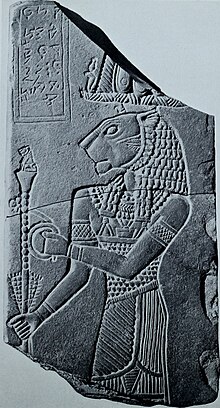
Back أباداماك Arabic Apedemak AST Apedemak Azerbaijani Апедемак Bulgarian Apedemak Catalan Apedemak German Apedemak Spanish Apedemak Basque Apédémak French Apedemak Hungarian
| Apedemek | |||||||
|---|---|---|---|---|---|---|---|
Nubian Lion God of War | |||||||
 Votive Plaque of King Tanyidamani and Apedemak, The Naqa kiosk, Excavation by John Garstang, 1909-1910, in the Temple of Apedemak, Meroe | |||||||
| Name in hieroglyphs |
Apedemak Jprmk | ||||||
| Major cult center | Lion Temple, Naqa | ||||||
| Consort | Amesemi | ||||||
| Equivalents | |||||||
| Roman | Jupiter | ||||||
| Part of a series on |
| Kushite religion |
|---|
 |
|
|
| Part of a series on |
| Ancient Egyptian religion |
|---|
 |
|
|
Apedemak or Apademak (originally, due to the absence of the /p/ phoneme in Meroitic, it was probably pronounced 'abademak' (Father king) [1]) was a major deity in the ancient Nubian and Kushite pantheon. Often depicted as a figure with a male human torso and a lion head, and at the temple of Naqa with a snakes body and a lion head, Apedemak was a war god worshiped by the Meroitic peoples inhabiting Kush. He is often considered the equivalent of Maahes the lion-headed war god of Egypt, despite a claim of the two not being counterparts.[2] As a war god, Apedemak came to symbolize martial power, military conquest, and empire. Apedemak is also closely associated with Amun, the state-sponsored Egyptian deity during the preceding Napatan period, and is assumed to hold an equal level of importance.
- ^ "The Meroitic Language and Writing System".
- ^ The Ancient World : Extraordinary People in Extraordinary Societies. Michael Shally-Jensen. Ipswich, Mass.: Salem Press. 2017. ISBN 978-1-68217-190-5. OCLC 975044922.
{{cite book}}: CS1 maint: others (link)